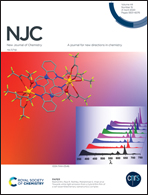Copillar[5]arene-rhodamine conjugate as a selective sensor for Hg2+ ions†
Abstract
A new copillar[5]arene coupled rhodamine probe 1 has been designed and synthesized. The molecular probe shows selective sensing of Hg2+ ions over a series of metal ions in CH3CN by exhibiting a color change of the solution as well as ‘turn-on’ fluorescence. Compound 1 also shows interaction with Cu2+ by exhibiting a different color and spectral changes. Furthermore, Hg2+ has been differentiated from Cu2+ by using tetrabutylammonium iodide (TBAI). While in the presence of TBAI, the reddish violet color of the 1–Cu2+ complex becomes colorless with the regeneration of the original electronic spectrum of 1; under identical conditions, the pink color of the 1-Hg2+ complex is not changed in the presence of TBAI. Model compound 2 with no pillar[5]arene moiety has been synthesized to validate the role of pillararene in the selectivity of metal ion sensing. Importantly, compound 2 does not show any selectivity in sensing under identical conditions. Complexation studies are performed by using UV-vis, fluorescence, FTIR and NMR spectroscopic methods.
![Graphical abstract: Copillar[5]arene-rhodamine conjugate as a selective sensor for Hg2+ ions](/en/Image/Get?imageInfo.ImageType=GA&imageInfo.ImageIdentifier.ManuscriptID=C9NJ06264E&imageInfo.ImageIdentifier.Year=2020)


 Please wait while we load your content...
Please wait while we load your content...